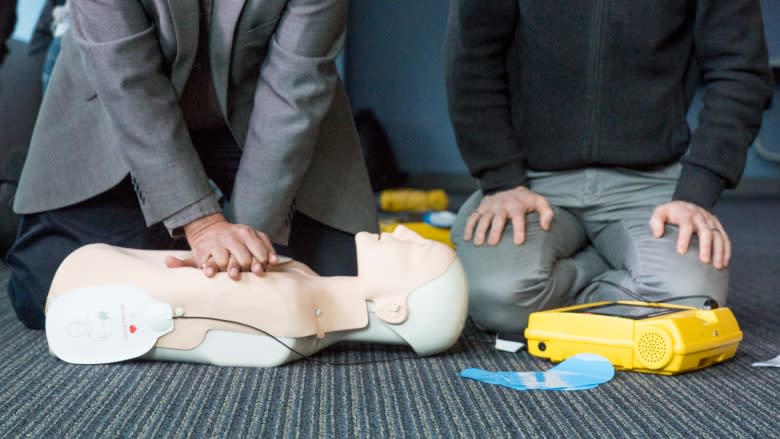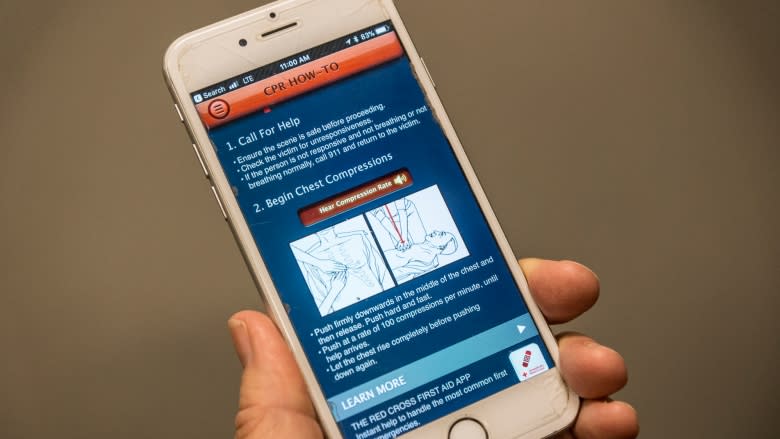CBC survey: does your school have a defibrillator?
By next week, all public schools in the New Westminster, B.C., will be equipped with automatic external defibrillators, even though installing the portable devices in schools is not required by the province's senior public health official.
"It's nice to know it's there," said Mark Gifford, chair of the New Westminster School Board.
Defibrillators are portable electronic devices that automatically diagnose life-threatening cardiac arrhythmias and send electric shocks through the chest wall of a person whose heart has stopped beating.
In B.C., there is no legislation requiring schools to have AEDs, and the office of the provincial health officer doesn't recommend it.
In a statement, the office said AEDs are rarely needed in a school setting unless a student or staff member has a pre-existing condition.
Instead, it said it supports putting defibrillators in settings where sudden cardiac arrest is more likely, such as recreation centres.
'People's lives have been saved'
But Dr. Sanjiv Gandhi, head of cardiac surgery at B.C. Children's Hospital, thinks all schools should carry them.
"It's totally bogus to say they don't help," he said. "There is mounds of evidence. People's lives have been saved by AEDs. I've seen it over."
Gandhi advocated to get them into the West Vancouver school district while his children were attending school there.
The New Westminster school board invested $35,000 to install 20 AEDs in schools and office buildings after a group of parents brought the issue to its attention last April.
"Our schools are more than just class environments. They're hubs for community activity," said Gifford.
Other school districts like Coquitlam, Powell River, and Comox Valley — to name just a few — have also decided to install the devices in every school. However, larger school districts like Vancouver and Surrey have not.
Does your school have one?
CBC News contacted every school district in B.C. to find out which public elementary and secondary schools have AEDs installed.
Check the table below to see if your child's school has an AED:
NOTE: The list is based on answers provided by school districts. If the district did not provide an answer, the field is left blank. Some school districts have AEDs that are for specific children. In most cases, districts didn't reveal that information due to privacy. You should check with your school directly to ensure the above information is up to date.
Don't see your school there? Or spot an error? Email tina.lovgreen@cbc.ca
Don't be afraid to dial 911
AEDs are just one of the tools available for the public to use in an unexpected loss of heart function in a person.
B.C. Ambulance dispatcher Colin Terry, who talked a Vancouver elementary school teacher through the CPR that saved a student's life, said there should be no reason for the public to be fearful or reluctant to call 911 in case of sudden cardiac arrest.
"We don't ask anyone to do anything that is dangerous," he said. "Our instructions are simple. Children can follow them. We will do the thinking, as long as you can communicate clearly," he said.
He said the key to survival in a sudden cardiac arrest is early recognition, early CPR and early defibrillation.
Without immediate help, brain damage starts within three minutes of cardiac arrest.
PulsePoint app
A new smartphone app called PulsePoint will alert users when somebody is in cardiac arrest in a public place nearby.
The app notifies people if someone within walking distance is a victim of sudden cardiac arrest.
The app does not keep records on who gets the alerts or responds to them, and it only reports events occurring in public places.
B.C. Emergency Health Services says people shouldn't be afraid to help and need to know they're covered by the Good Samaritan act. Civilians cannot be held liable for any additional harm if they do step in to help.
Emergency services says the smartphone alert could also save lives by showing users a map pinpointing the location of nearby public defibrillators.
The app also has a CPR how-to and a compression rate beat for users to follow.
B.C. is the first province in Canada to offer the program.




